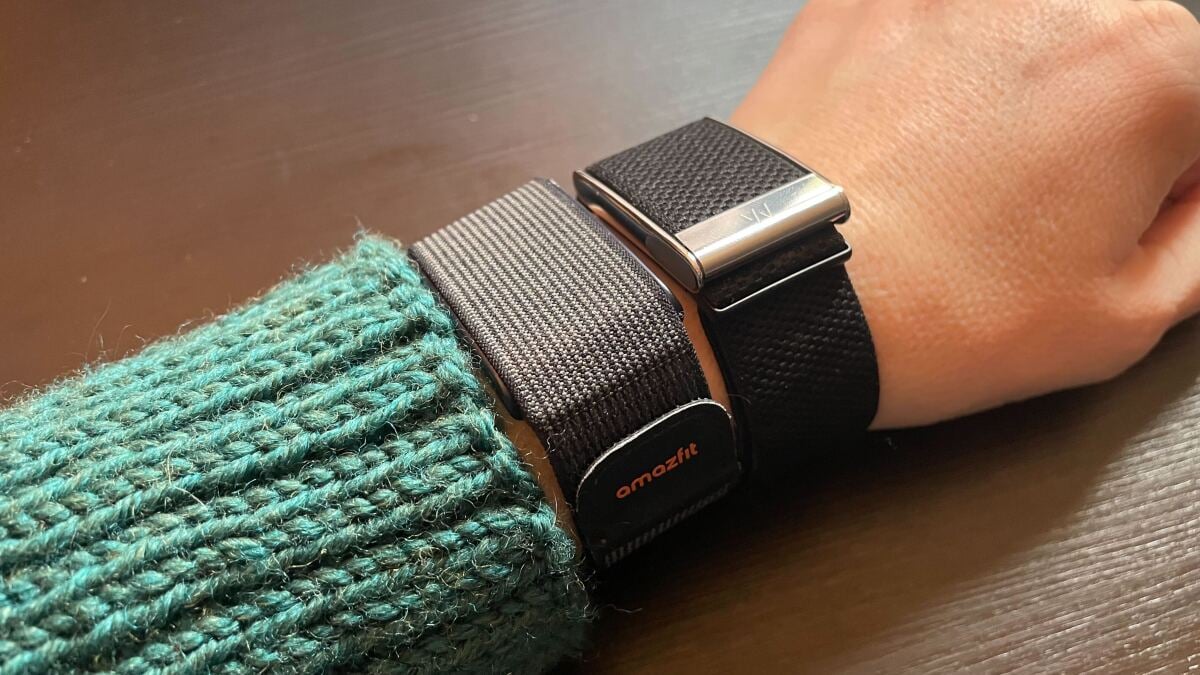
Comfort and appearance
First, a note about what you’ll see in the photos. The Whoop I’m using for the comparison is an MG (“medical grade”) model, rather than a regular 5.0. That said, the 5.0 and the MG are the same size and shape, and the MG can do everything the 5.0 can—it just has a few extra features, including the ability to take an ECG reading. That’s why the one in my photo has a metal clasp. I won’t be considering any of the MG-specific features in this comparison, as I’m trying to compare Whoop in general to its Amazfit competitor.
Let’s talk size first. The Helio has a longer body than the Whoop, about 42 millimeters according to my measurements. It looks a little bit chunky and awkward if you have small wrists. The Whoop device is about 35 millimeters long. So the Whoop gets points for being smaller and sleeker.
Both devices are about the same thickness, though (about 11 millimeters) and each hides neatly under its 21-millimeter strap. The Whoop has a smoother shape against your skin, versus the Helio’s somewhat protruding sensor.
The Amazfit’s strap is a simple Velcro one that attaches with ordinary watch band pins. You could replace it with any old 22-millimeter watch band if you didn’t mind the blank plastic face of the device showing. On the downside, the factory-issued strap is a bit long for people with small wrists; I have six-inch wrists and I have it pulled about as tight as it will go. Whoop’s strap isn’t as easy to replace, since the attachments are specific to this device. (Extra bands start at $49, although I’ve seen knockoffs for $25.)
Both devices can be worn on the arm instead of the wrist, if you prefer. Whoop also has a line of garments, mostly underwear, that have a pocket to slip the device into.
What these devices actually do
Before we dig into the differences, let’s talk about what you can expect from this type of wristband-based fitness tracker. Obviously, neither one has a screen, so we won’t worry about display types or brightness or much on-device usability. The purpose of these trackers is to read data from your body and feed it to an app on your phone.
Sleep tracking: Both the Whoop and Helio read data (mainly your heart rate) while you’re asleep. They use this to determine your resting heart rate, HRV, sleep duration, and make an educated guess at sleep stages like how much REM or deep sleep you got.
Workout tracking: These devices can both measure your heart rate during exercise. They can automatically detect some types of exercise, but the best way to record a workout accurately is to hit a “start” button on your phone, and then stop the workout on your phone when you’re done. If you run or walk with your phone in your pocket, the device can use your phone’s GPS to track how far and how fast you went. Otherwise, it just records heart rate data while you’re working out, and syncs to your phone at the end of the workout.
Recovery tracking: Whoop’s original, somewhat groundbreaking idea was that it could use sleep data to tell you how recovered you are today from the workouts you did yesterday. (It can also do the reverse, suggesting a workout intensity based on how well you slept.) Now most devices can do some kind of recovery tracking, so this isn’t unique, but Whoop still does it very well. Amazfit has its own Readiness metric along these lines, as well as a Biocharge number that is similar to Garmin’s Body Battery. Biocharge is more dynamic than a simple readiness score, since it’s supposed to behave like a battery that you “charge” with sleep and run down with stress or exercise.
“Stress” tracking: I don’t put much stock in stress tracking, to be honest, but both of these devices will measure your heart rate and HRV during the day and translate that into a measure of what they say is stress.
Put that all together, and the idea is that you wear the device all day and let it track all the health metrics above. Whoop’s app does some more things that Amazfit’s doesn’t, and I’ll get into them below.
Both devices do all of the above adequately. The sleep and workout data more or less match each other as well as other devices I’ve worn alongside them. (No two apps will report the exact same sleep stages, but the results from both are plausible.) I’ll cover workout accuracy below—but, spoiler, both devices record heart rate well. Recovery and stress tracking are harder to compare; there’s no objective way to say which device is more “correct.”
Pricing
The whole reason we’re having this conversation is because of the price difference between these devices, so let’s crunch the numbers. The Amazfit Helio strap costs $99.99 and doesn’t require a subscription for basic functionality. There is an optional premium subscription, of course: Zepp Aura.
Zepp Aura gives you weekly reports on your sleep; 14-day reports on your risk of sleep health issues like apnea, restless leg syndrome, and insomnia; and relaxation music “personalized to your heart rate data.” The cost is $69.99/year.
Whoop, on the other hand, doesn’t charge you anything for the device, but includes it as a package deal when you pay for a year’s subscription. That means you have to pay the same price to renew next year. There are three tiers of subscription:
Whoop One, $199/year, with a 5.0 device (this tier is missing some of the health data)
Whoop Peak, $239/year, also with a 5.0 device (the “regular” subscription)
Whoop Life, $359/year, with an MG device (the extra cost gives you ECG readings and the controversial blood pressure feature)
So the Helio comes out much, much cheaper. At minimum you’re paying half the price ($99.99 versus $199 for a year of Whoop One). If you were to go with the middle-of-the-road Whoop subscription, and stick with it for three years, you’d pay $717 in total, making it more than seven times as expensive as the Helio.
Accuracy
I’m impressed by both devices when it comes to heart rate accuracy. (Neither has its own GPS, so that’s not a factor here). The graph above is from a run where I wore the Helio (orange), Whoop (blue), and a Garmin device linked to my trusty Coospo chest strap. You’ll always get the most accurate readings from a chest strap, so I use it as a reference. And just look at how pretty those graphs are! All three lines are basically identical. I even added a zoomed-in section so you can see how closely they match.
Whoop has come a long way from its long-ago 3.0 device that gave wonky heart rate readings. The 5.0 generation reads heart rate quite well, as does Amazfit’s sensor. This is a dead even tie on heart rate accuracy.
Battery life and charging
The Whoop wins on battery life, getting “14+” days according to the company. With light use, I managed about 20. Amazfit says the Helio strap gets “up to 10 days” battery life, which also matches with my experience—I tend to get about a week, sometimes more.
The Helio strap charges in the same way as the other Amazfit devices I’ve tried: you plug your own USB-C cable into a little magnetic puck and stick it onto the back of the device. The Whoop device, on the other hand, comes with a charging brick that you snap on, sans cord, and can walk around while the battery in the brick tops up your device. (That is, unless you opted for the budget Whoop One option. That one comes with a wired charger.)
What the Whoop has that the Helio Strap doesn’t
This is the section of this review where we’re going to see the biggest differences. Both devices are about the same size, can track your heart rate, etc. Yawn. Here we’ll discuss why people pay $239/year for Whoop. If you can live without this stuff, you can happily buy the Helio strap and save a ton of money. But if the stuff I describe in this section is what you really want, you’ll need to cough up to get it.
The habit journal
Whoop asks you each day what you did, and you can select what questions you’d like it to ask. This way you can track how your recovery is affected by things like alcohol, illness, eating vegetables, taking medications, or having a pet in bed with you. (There are tons to choose from). The app analyzes the data and tells you which items tend to help or hurt your recovery.
Whoop coach
This is one of the few AI chatbot-style features in a fitness app that is actually useful. The Whoop Coach can give you highlights of your data for the day, and recommend workouts that will meet the app’s recommendations. For example, I have a high recovery score today and already did a quick cardio workout, so Whoop Coach suggests I get in a 30-minute weightlifting session. (It also suggests I try to avoid alcohol and late meals tonight, since we both know—based on the habit journal—that those tend to mess up my sleep.)
Sleep coach and smart alarms
Instead of just setting an alarm for a specific time, the Whoop sleep coach can advise me on how much sleep I need, and suggest a bedtime and a wake-up time. If you sleep irregularly—you’re an athlete who’s always on the road for games, perhaps—you can find out how much sleep you need to either perform at your peak or just to get by and survive the next day.
When setting your alarm, you can tell Whoop whether you want it to give you a wake-up time that just barely gets you into the green recovery zone, or a time that improves your bedtime consistency, or a time that gets you a certain number of hours of sleep. The device itself can then buzz on your wrist when morning comes.
Healthspan
This one is kind of gimmicky, but people like it, so I’ll include it among Whoop’s perks. You can get Whoop’s idea of how old you really are at heart. Then you can feel good if you’re younger than you really are, or feel motivated to change your habits if you’re aging quickly.
Unlike some other apps that rank me as 10 years younger based on my exercise habits and my weight, Whoop grades me more harshly, saying I’m barely one year younger than my calendar age. According to the app, my cardio fitness gains me a little youth, but my daily stress and my recent poor sleep are making me age more quickly. Do I think this is accurate in terms of actual longevity? Not at all. But I do appreciate the analysis that shows me what to work on.



